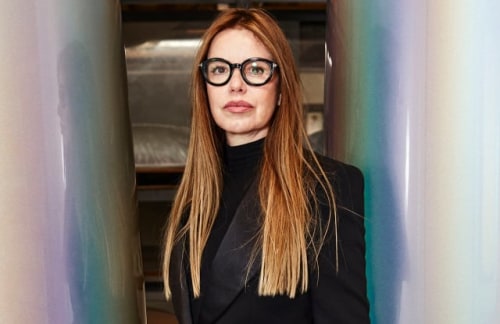
Visiting Gisela Colón’s studio at the foot of the San Gabriel Mountains in the dusty Los Angeles suburb of Duarte is a bit like stumbling on Tony Stark’s secret lab.
Inside an unassuming industrial park, the space is aglow and abuzz with work being done on the Los Angeles artist’s iridescent molded acrylic monoliths and wall-mounted biometric pods. They have a mysterious life force conjuring both the ancient divine feminine and the sci-fi future.
Colón created the term “organic minimalism” to describe her work — luminous rounded forms cast in multiple layers of optical plastic that create the effect of being lit from within and change color depending on a viewer’s vantage point.
“The history of minimalism was very staid in that it followed a very strict geometry, 90-degree angles, corners, lines and the work was devoid of content, identity and anything feminist,” she explained. “It used to be, you couldn’t show any evidence of being a woman in your work or you’d get rejected. If the work didn’t look like a man made it in the Sixties and Seventies, you weren’t going to get respect in the art world.”
That was then. In the past eight years, Colón has carved out space in the traditionally male-dominated minimalism canon and California Light and Space movement, exhibiting her work at the L.A. County Museum of Art, the Perez Museum in Miami and the Crystal Bridges Museum of Art in Bentonville, Ark., among others.
This weekend, she is opening a solo exhibition titled “Existential Time” at Gavlak Gallery in Palm Beach, Fla., as part of New Wave Art Wknd. It features new rectanguloid wall works, each one in a different color spectrum based on a mineral or an element in nature, exploring the collapse and refraction of time as experienced during the pandemic quarantine.
Colón is also one of 10 artists customizing the Lady Dior handbag as part of the fifth Lady Dior Art Project launching early next year, alongside some of her feminist idols, like Judy Chicago.
“Gisela’s work is a prime example of how art can engage with the complex intersection of the organic and the man-made,” said Gavlak owner Sarah Gavlak. “Her practice is extremely prescient. The curiosity around the monolith recently discovered in Utah’s Red Rock country speaks to the power of Gisela’s own ‘Monolths’ series that explores how we as humans experience the unknown.”
“I love minimalism because it embodies that universal energy that anyone can tap into. It’s very democratic, you don’t have to be knowledgeable about art to have a visceral connection to the work because it’s so pure,” said Colón, who begins by drawing “gelatinous forms” in pen and ink with one swipe of the hand, until she gets the perfect oval or rectanguloid shape. Then she magnifies the ink line onto a 4-by-6 plywood piece, which becomes the mold that shapes the layers of acrylic.
Each mold shapes one layer, and each piece has six to seven layers inside. “It’s a form inside of a form inside of a form, it’s the layering technique that causes the light to refract. There’s no paint. It’s all these optical acrylics. When the light goes through the layers they act like a prism,” she said of her sculptures, which embody much of the Southern California experience — aerospace, Laurel Canyon crystal hippie and Hollywood plastic fantastic — in one. The forms are cut, formed and assembled by two employees who came with the studio space, which was a former plastics manufacturer.
Colón grew up in San Juan, Puerto Rico, where she had a lot of freedom to run around the rainforest and the beach, among animals and plants. “I had a pet rooster in my bed,” she said, laughing. “I put that freedom, spark of life and connection to the earth into the work. It’s not traditional minimalism from the Sixties, like Donald Judd metal box. It’s transcending the material to make it feel like it is alive.”
She moved to L.A. to study and practice law in the early Nineties, and came to art later in life, when she started to become interested in the California Light and Space movement. She reached out and eventually struck up friendships with several of those artists, including DeWain Valentine, Mary Corse, Peter Alexander and Larry Bell, and studied the theories of Robert Irwin, James Turrell, Chicago, and others to develop her own around gender, in particular.
“I can make a giant phallic object that has masculine references that are destructive like projectiles or bullets and soften it into this ethereal thing,” she explained.
A significant milestone was taking her work to Desert X in Saudi Arabia last year. “It showed it in a completely different setting, in the natural world at the crossroads of ancient and modern culture,” she said. “A lot of the artists were criticized for going because of human rights violations…but if you don’t have the faith as an artist to bring cultures together, what are you doing? The fact we were received, three women artists from the Western world, and I was able to show a work with a phallic feeling, that was pretty incredible.”
Looking to the future, she’s interested in how her vision can translate to other things, like objects (a collaboration with Bernardaud is in the works), furniture, or even fashion. “I want to do the runway one day — all futuristic,” said Colon, who is dressed in a Tom Ford tuxedo jacket, track pants and Alexander McQueen sneakers.
And she will continue to be inspired by nature, science, light and place. “Los Angeles is pretty amazing if you think about it as a metropolis and how we’re all connected through these freeways gyrating constantly in motion,” said the artist, who commutes an hour from the West Valley to her studio every day. “It’s just freedom and expansive energy. You can fulfill your dreams here if you have a vision.”